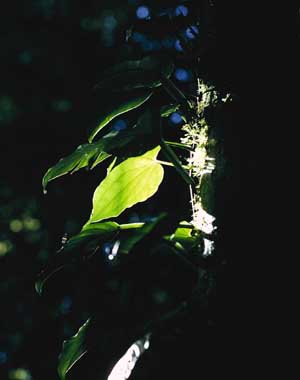|
|
 61 short-term light capture DHJanzen100372.jpg high resolution
|
|
| In the deep understory of forest, and especially in tropical forests, as the sun moves through its daily arc overhead, beams of light pentrate through holes in the canopy directly to the forest floor. In this image, one of these beams hits an epiphyte on a tree trunk at ground level. For ten? minutes that leaf is bathed in light as intense (and nearly as hot) as the light directly hiting the canopy leaves far above. The plant is confronted with two options, and I do not know which is followed by this particular species of plant. It can simply turn off its photosynthetic processes that operate best in deep shade. In this case, it does not make use of this ten minute burst of potentially avaiable energy, which probably contains as many photons as that leaf sees during all of the remainder of the day. Alternatively, its leaves can sit in the deep shade doing next to no energy harvest, and crank up very rapidly when impacted by a sun beam. In this case, the plant is dependent on being on one of those places (10% of the forest floor?) that are hit by a direct beam of light each day. But, then again, the world is highly heterogeneous for quality sites for individual plants. Both strategies are used in the deeply shady tropical rain forest understory. | ||
back to lecture slides
or skip to: